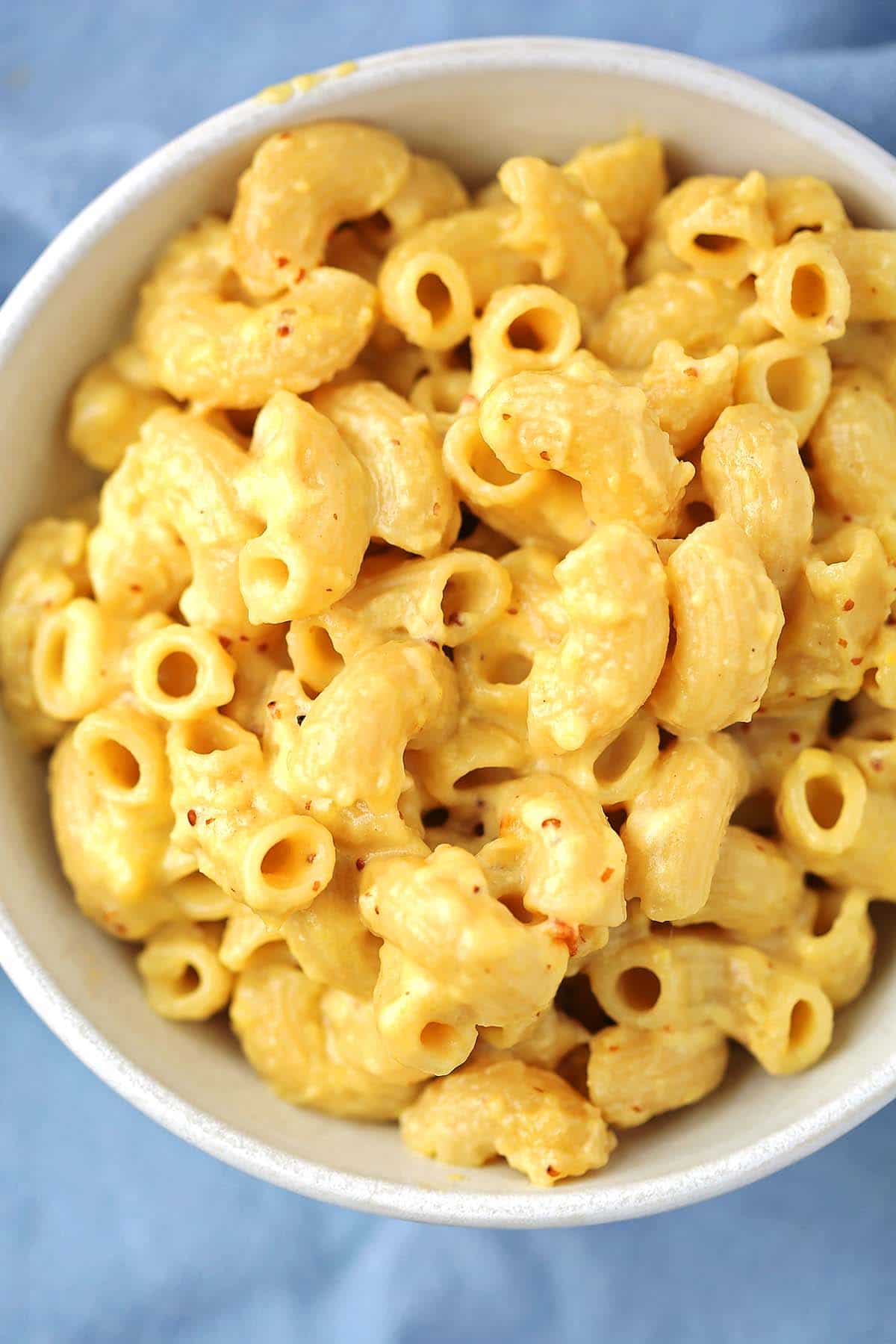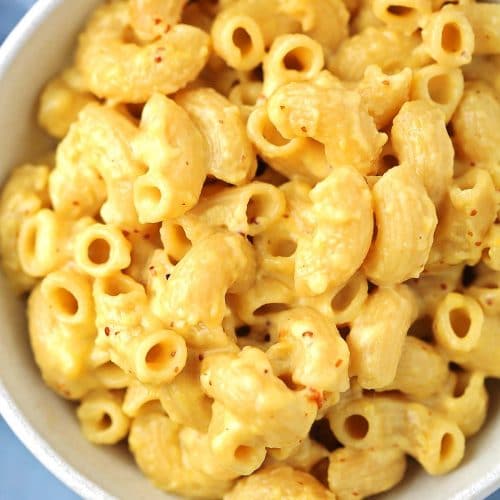This easy Dutch oven mac and cheese is made completely in one pot. This comforting pasta dish is cheesy, creamy, and extra flavorful. It’s made without any breadcrumbs or flour, and no fancy ingredients are needed.
Jump to Recipe
Here is a visual overview of the ingredients you will need for this recipe with step-by-step photos and tips below. If you are looking for a simple recipe card, scroll down to the bottom of this page.

Macaroni– when making homemade mac and cheese, I like to use elbow macaroni, Conchiglie, or Gemelli pasta. You can use any small-shaped pasta.
Manchego Cheese – Manchego is a Spanish cheese with a distinct flavor and a firm texture. It adds a unique twist and depth of flavor to the dish.
Mild Cheddar or Sharp Cheddar. Use freshly shredded cheese.
Milk – whole milk for a creamier texture; feel free to substitute whole milk with another kind.
Nutritional Yeast – I use nutritional yeast to enhance the “cheesy flavor” and add yellow color naturally.
Butter – I used salted butter; if using unsalted kind, you will need to add more salt.
Dijon Mustard – Choose “course ground” mustard for this recipe.
Step 1. Cooking the pasta.
First, to make this creamy homemade mac and cheese, you’ll need to cook the pasta. Fill a large Dutch oven pot with water and cook macaroni in a pot, following the package directions.
Cook pasta al dente; once cooked, drain, don’t rinse, and leave the pasta to sit in the colander.

Step 2. Making the cheesy sauce.
In the same cast-iron Dutch oven pot over medium heat, melt butter, add milk and mustard, whisking continuously. Once butter is melted, add freshly shredded cheese and nutritional yeast, and continue to whisk the cheese sauce till combined. Remove from the heat, taste, and adjust mustard and salt as desired.

Step 3. Combining macaroni with cheese sauce.
To the Dutch oven pot with cheesy sauce, add cooked macaroni and stir to combine.

Step 4. Baking mac and cheese- Optional step.
You can entirely skip this step and not bake mac and cheese at all! Or bake it if you would like to turn this into a baked version with a cheesy crispy crust on top.
Sprinkle extra cheese and some nutritional yeast on top of baked macaroni and broil for 3 minutes in the preheated oven till the golden brown crust is formed. Serve mac and cheese warm.

You can substitute ingredients in mac and cheese with alternative ingredients, depending on your dietary preferences or restrictions. Here are a few options:
Manchego – instead of Manchego cheese, you can use Monterey Jack Cheese.
Whole milk – you can replace milk with non-dairy alternatives such as almond milk, soy milk, oat milk, or coconut milk. Choose an unsweetened variety for the best results.
Butter – to replace butter, there are plenty of options, such as yogurt or mayo.
There are a few pasta options that are commonly used and loved for making mac and cheese:
Elbow Macaroni: Elbow macaroni is the classic choice for mac and cheese. It’s small curved shape and hollow center allow the cheese sauce to cling to the pasta, creating a perfect bite each time.
Cavatappi: Cavatappi is a corkscrew-shaped pasta that works well for mac and cheese. Its spiral shape provides nooks and crannies that can hold onto the cheese sauce, resulting in a delicious and cheesy bite.
Shells: Shell-shaped pasta, such as medium or large shells (conchiglie), can be a great choice for mac and cheese. The concave shape of the shells catches and holds the sauce, making each bite extra cheesy.
The best cheese for mac and cheese depends on personal preference and the flavor profile you want to achieve. However, here are some popular favorite cheeses that are commonly used and loved for making mac and cheese:
It’s important to note that leftover mac and cheese should be consumed within 3-5 days when stored in the refrigerator.
If you have a larger quantity that you won’t be able to consume within that timeframe, you can also freeze the leftovers for longer-term storage.
To store leftover mac and cheese properly, follow these steps:
There are numerous ingredients you can add to macaroni and cheese to enhance its flavor and make it even more delicious. Here are some popular options:
Add crumbled prosciutto. Adding crispy prosciutto can provide a savory and rich element to your mac and cheese. It adds texture and a burst of flavor.
Seasoned Breadcrumbs: Toasted bread crumbs with added seasonings like garlic powder, herbs, or grated Parmesan can provide a crunchy and flavorful topping for baked mac and cheese.
Add more veggies: broccoli, shaved Brussels sprouts, roasted asparagus.
Make it extra flavorful, add extra spices: powdered garlic, dry herbs like chives or parsley, and garnish with chopped green onion.
Make it extra creamy: add some cream cheese or heavy cream to the pasta sauce.

If you’d like to serve it with some complementary dishes, here are a few options:
Salad: A fresh and crisp salad can provide a nice contrast to the rich and creamy mac and cheese. Consider serving a kale crunch salad that looks festive and has a refreshing flavor.
Roasted Vegetables: Roasted vegetables make a flavorful and nutritious accompaniment to mac and cheese: serve it with roasted cauliflower or broccoli, or Brussels sprouts.
Steamed or Sautéed Greens: Lightly steamed or sautéed greens, such as spinach, kale, or Swiss chard, can add a pop of color and freshness to your meal. Season them with garlic, lemon juice, or a sprinkle of Parmesan for added flavor.
Grilled or Roasted Chicken: For a protein boost, serve mac and cheese with grilled or roasted chicken breast or thighs. Season the chicken with herbs, spices, or a marinade of your choice for extra flavor.
Pulled Pork: Tender and flavorful pulled pork can be a tasty pairing with mac and cheese. Top the mac and cheese with some pulled pork for a hearty and satisfying meal.
Pickles or Tangy Relish: Adding a side of tangy pickles or sweet pickle relish can provide a refreshing and zesty contrast to the richness of mac and cheese.
Manchego cheese is a firm cheese made from sheep’s milk. It’s less salty than Parmesan cheese.
To make the cheese sauce, you will need to melt butter; once melted, add milk and shredded cheese with the ingredients: mustard, salt, dry herbs, and spices.
Making mac and cheese from scratch consist of 3 steps: cooking macaroni, making cheese sauce, and combining pasta with sauce.
To reheat mac and cheese in the oven, preheat the oven to 350F degrees; place the covered Dutch oven with mac and cheese in the preheated oven and heat for 15 minutes.
Adding mustard to mac and cheese is a common practice that can enhance the flavor profile of the dish. Mustard brings a tangy and slightly sharp taste that complements the richness of the cheese and adds depth to the overall flavor. When adding mustard to mac and cheese, it’s best to start with a small amount and gradually adjust to your taste preferences. Dijon mustard or whole-grain mustard are popular choices.
It is generally not recommended to rinse the cooked pasta for mac and cheese. Rinsing pasta after cooking removes the starches that naturally cling to the pasta, which are essential for helping the sauce adhere to the noodles. When making mac and cheese, you want the pasta to have a slightly sticky surface to hold onto the cheese sauce and create a creamy texture.

Did you try this recipe? I love hearing from you! Don’t forget to rate and leave a comment below.






